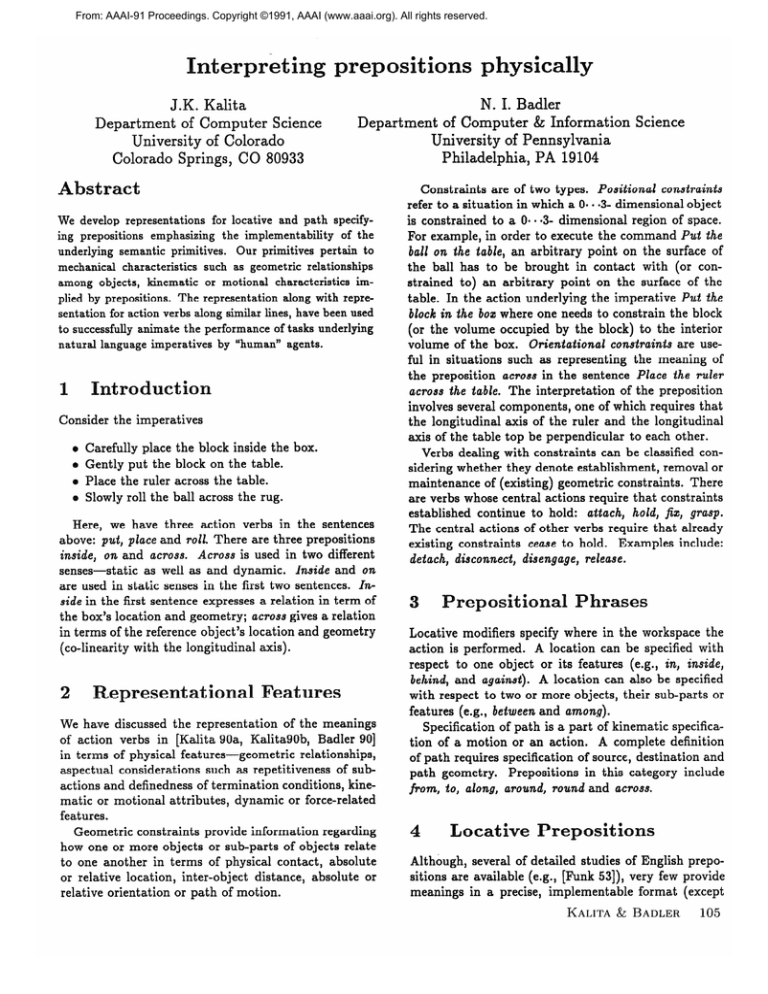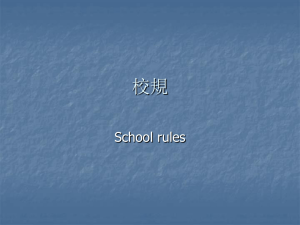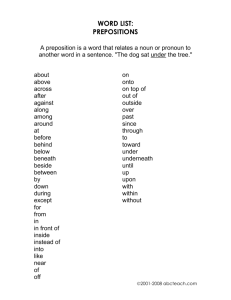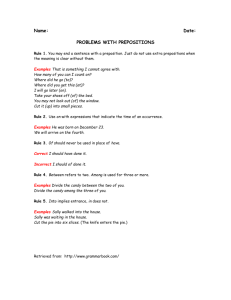
From: AAAI-91 Proceedings. Copyright ©1991, AAAI (www.aaai.org). All rights reserved.
hysically
N. I. Badler
Department of Computer & Information
University of Pennsylvania
Philadelphia, PA 19104
J.K. Kalita
Department of Computer Science
University of Colorado
Colorado Springs, CO 80933
Abstract
We develop
representations
ing prepositions
underlying
mechanical
among
semantic
characteristics
objects,
or
and path
specify-
implementability
Our
such
kinematic
for action
to successfully
the
primitives.
plied by prepositions.
sentation
for locative
emphasizing
primitives
as geometric
motional
of the
pertain
characteristics
The representation
to
relationships
im-
along with repre-
verbs along similar lines, have been used
animate
the performance
natural
language
imperatives
1
ntroduction
of tasks
by “human”
underlying
agents.
Consider the imperatives
o Carefully place
e Gently put the
a Place the ruler
m Slowly roll the
the block inside the box.
block on the table.
across the table.
ball across the rug.
Here, we have three action verbs in the sentences
above: put, place and roIZ. There are three prepositions
inside, on and across. Across is used in two different
senses-static
as well as and dynamic. Inside and on
are used in static senses in the first two sentences. Inside in the first sentence expresses a relation in term of
the box’s location and geometry; across gives a relation
in terms of the reference object’s location and geometry
(co-linearity with the longitudinal axis).
2
epresent at io
We have discussed the representation of the meanings
of action verbs in [Kalita 90a, KalitaSOb, Badler 901
in terms of physical features-geometric
relationships,
aspectual considerations such as repetitiveness of subactions and definedness of termination conditions, kinematic or motional attributes, dynamic or force-related
features.
Geometric constraints provide information regarding
how one or more objects or sub-parts of objects relate
to one another in terms of physical contact, absolute
or relative location, inter-object distance, absolute or
relative orientation or path of motion.
Science
Constraints are of two types. Positional constraints
refer to a situation in which a 0-e l
3- dimensional object
3- dimensional region of space.
is constrained to a Oa. l
For example, in order to execute the command Put the
ball on the table, an arbitrary point on the surface of
the ball has to be brought in contact with (or constrained to) an arbitrary point on the surface of the
table. In the action underlying the imperative Put the
block in the boz where one needs to constrain the block
(or the volume occupied by the block) to the interior
volume of the box. Orientational
constraints are useful in situations such as representing the meaning of
the preposition across in the sentence PZace the ruler
across the table. The interpretation of the preposition
involves several components, one of which requires that
the longitudinal axis of the ruler and the longitudinal
axis of the table top be perpendicular to each other.
Verbs dealing with constraints can be classified considering whether they denote establishment, removal or
maintenance of (existing) geometric constraints. There
are verbs whose central actions require that constraints
established continue to hold: attach, hold, fiz, grasp.
The central actions of other verbs require that already
existing constraints cease to hold. Examples include:
detach,
disconnect,
disengage,
repositional
release.
bases
Locative modifiers specify where in the workspace the
action is performed. A location can be specified with
respect to one object or its features (e.g., in, inside,
behind, and against).
A location can also be specified
with respect to two or more objects, their sub-parts or
features (e.g., between and among).
Specification of path is a part of kinematic specification of a motion or an action. A complete definition
of path requires specification of source, destination and
path geometry. Prepositions in this category include
from, to, along, around, round and across.
Locative
repositions
Although, several of detailed studies of English prepositions are available (e.g., [Punk 53]), very few provide
meanings in a precise, implementable format (except
KALITA & BADLER
105
[Badler 751 and [Gangel 841). We use an extended version of Talmy’s [1983] schema approach made suitable
for computational purposes. We have also been influenced by [Herskovits 861.
We organize the meaning of a preposition such as on
in the following way:
on
0721 on2 . .a on,
At the top level, we have the preposition itself. The
second level contains a list of senses of the preposition
for which we have lexical entries.
Generally speaking, one might be able to define a general meaning which resides in the root and then provide
inference procedures or heuristics for deriving representation for the senses. However, these inference procedures or heuristics are still neither well understood nor
exhaustively enumerated although Herskovits discusses
them in a general manner. For the purposes of obtaining lexical entries in this paper, we consider one sense
of each preposition to keep our discussions simple.
The structure used for representing meanings of locative prepositions is in terms of a representation template: geometric-relation.
A geometric relation is specified in two ways. The first, which represents a simple
geometric relation is a frame with the slots:
geometric-relation:
spatial-type:
source-constraint-space:
destination-constraint-space:
distance:
weight:
selectional-restrictions:
The second is for more complex cases which are composed of two or more geometric relations to be satisfied
simultaneously:
geometric-relation:
( g-union g-relation-l
where g-reIation-i
4.1
g-relation-2
l
. . g-relation-n
}
is simple or complex.
A Representation
for on
The sense of on we are interested in is seen in the sentence Put the block on the tabZe. The relevant use type
of on from Herskovits is spatial entity supported by physicab object. A handbook describes it as in contact with
upper surface of; above and supported by [Funk 531.
The relations implied in this meaning of on are: contact, support and above. The relationship of support is
difficult to define. Fahlman devised complex heuristic
and mathematical tests to determine if an assembly of
blocks can be supported by another [1974]. We do not
106
GENERATION
AND INTERACTION
define support in such complex manners. Our representation of support is indirect and symbolic. We describe
this meaning or sense of on as
on (X,Y) egeometric-relation:
positional
spatial- type:
source-constraint-space:
any-of
(self-supporting-spaces-of
(X))
destination-constraint-space:
any-of
(supporter-surfaces-of
(Y)))
selectional-restrictions:
horizontal-p (destination-constraint-space)
equal ((direction-of (normal-to
destination-constraint-space),
“global-up”)
free-p (destination-constraint-space)
It is impossible to capture all selectional restrictions or
applicability conditions associated with any word in a
natural language [Winograd 801. No matter what conditions are imposed, one can always fabricate an odd
context in which the condition does not hold.
Given a geometric object, the geometric function se&supporting-spaces-of
obtains a list containing surfaces,
lines or points on the object on which it can support
itself. For example, a cube can be supported on any of
its six faces, and a sphere on any point on its surface.
The function supporting-surfaces-of
takes an object as
an argument and finds outer surfaces on it on which
other objects can be supported. To do so, it may find
out if there are parts whose function is primarily to
support other objects (e.g., the top surface of a table),
failing which it finds out if there are parts which are
normally horizontal, or are horizontal at the current
time.
The definition for on (X, Y) given above specifies
all three relations: contact, support and above. Contact is specified in terms of a geometric relation between a source and a destination constraint space. Support is specified indirectly by requiring that the sourceconstraint-space
is a self-supporting-space
of X and that
the destination-constraint-space
is a supporter-surfaceof of Y. Above is specified in terms of restrictions we
impose on the direction of the normal to the destinationconstraint-space
and by requiring that the destinationconstraint-space
is horizontal.
egresentation
for in
The handbook defines this meaning as within the bounds
of, contained in or included within [Funk 531. According
to Herskovits this use type for in is spatial entity in a
container. We specify this meaning of in as
in (X,Y)
c-
geometric-relation:
spatial-type:
positional
volume-of (X)
source-constraint-space:
destination-constraint-space:
interior-of (Y)
selectional-restrictions:
or (container-p (Y),
container-p (any-of (sub-parts-of (Y))))
size-of (X) 5 size-of (Y)
normally-oriented (Y)
A container is an object which can hold one or more
objects such that the object is “surrounded by” the volume defined by the boundaries of the container. It is
a concept which is difficult to define clearly, although
heuristics can be devised to recognize whether an object is a container. For our purposes, if an object or any
of its part(s) can work as container(s), we will label it
(them) as such in the finction slot in its representation.
The second condition is due to Cooper [Cooper 681. The
third condition is due to Herskovits who explains its necessity by stating that the sentence The bread is in the
bowl is pragmatically unacceptable if the bowl is upside
down and covers the bread under it [Herskovits 861.
rejective
The prepositions considered in this section are called
projective because they define directions about an object, and specify the location of another object in relation to these directions [Herskovits $61.
First, we define a global coordinate system, assumed
to be placed in front of the work area.
+-ve 2
-ve 2
+ve
X
-ve X
+ve Y
-ve Y
Aligned against gravity; also called
the global-up direction.
Same as the direction of gravity;
also called globaLdown axis.
Also called glo baEright.
It is the globaLZeft direction.
It is the global-front direction.
This is the globaLback direction.
These six axes are called haZf axes [Herskovits 861. A
full axis is a two-directional line constituted from a pair
of companion half axes. We define a half axial plane as a
plane which passes through one half axis and a full axis.
Two companion half axial planes constitute a full axial
plane. For instance, left-right full axial plane is a true
planar surface extending to infinity in all directions and
passing through the left-right and up-down full axes.
We also establish a reference system rooted at the
center of volume of the object under consideration. Assuming we have one animate actor and the objects manipulated are inanimate, it is sufficient to consider the
canonical encounter situation for this reference systems.
Figure 1: The Back Zone
Here, it is assumed that the observer is situated at some
point directly in front of the object.
Douglas et al characterize 2-D specialized regions defined by the area occupied by an object for defining
projective prepositions [Douglas 871. They define pairs
such as front and back in terms of two-dimensional regions obtained by projecting the area occupied by the
objects. We treat these projective prepositions in terms
of three dimensional volumes. For example, to define
behind an object, we construct a volume called the back
zone of the object by doing the following:
1. Draw two tangent planes to the object parallel to
the front-back full axial plane.
2. Draw two tangent planes to the landmark object
parallel to the left-right full axial plane.
3. The contiguous volume bounded by these four
planes and the volume of the object forms the back
zone of the object. This is also shown in figure 1.
5.1 Behind
Having understood the concept of back zone, we define
the concept of behind. The definition requires that we
make the back-front axial planes of Y and X coincident,
and that the centroid of the first object be contained
within the back-zone of Y. The lexical entry is
behind (X,Y)
c-
c g- union
( geometric-relation:
positional
spatial-type:
source-constraint-space:
back-half-axial-plane
destination-constraint-space:
back-half-axial-plane
(Y))) }
( geometric-relation:
spatial-type:
positional
source-constraint-space:
centroid (X)
destination-constraint-space:back-zone
(Y)))
KALITA & BADLER
(X)
} )
107
J
In other words, object Y is properly behind object X if
1) behind half axial planes of X and Y coincide, 2) the
centroid of X is in the back-zone of Y. Problems due to
relative sizes of the objects is taken care of by the underlying constraint satisfaction techniques and the use
of weight slot in the template for constraint representation. Meanings of a few other projective prepositions
such as in front of and Zeft of can be defined in a similar
manner.
6
Three-object
6.1
Between
o Projection-zone(A)
is in the direction from A to B.
Projection-zone(B)
is in the direction from B to A.
The intersection
the between-zone
of these two projection
zones obtains
(X, A, B).
between (X,A,B) tgeometric-relation:
spatial-type:
positional
source-constraint-space:
volume-of (X)
destination-constraint-space:between-zone
(A,B)
7
Path prepositions
the table to the other along an edge.
called
path-specification
path-specification:
source:
destination:
path-geometry:
This structure is used for describing meanings of prepositions which specify paths which may be partial.
108
GENERATION
AND INTERACTION
Across has two types of meanings-dynamic
and static
(locative) meaning. The dynamic meaning implies a
journey across an object, whereas the static meaning
implies a location between two lines (edges) perpendicular to them and touching, and (possibly) extending
beyond them. The dynamic sense of across is seen in:
e Roll/Slide/Move the block/ball across the board.
across (X, Y) tpath-description
source:
any-of (exterior-edges-of (Y, parallel-to
(longitudinal-axis (Y))))
destination:any-of (exterior-edges-of (Y, parallel-to
(longitudinal-axis (Y))))
path-geometry: straight-line
selectional-restrictions:
destination # source
has-axis (X, longitudinal)
angle-between
(path-geometry, longitudinal-axis (Y), 90°)
length (Y) 2 width (Y)
length (Y) >
(dimension-of X (along-direction
(longitudinal-axis Y))
The longitudinal axis of an object is the axis along which
the length of an object is measured. There are a number of selectional restrictions imposed on the objects X
and Yalso. For example, the reason for the fourth selectional restriction can be gauged from the two phrases:
across the road and along the road.
8
Specification of path needs, at least, the following
components: source, destination, and path geometry.
All components can be seen in the following example
(slightly contrived):
Move the block from one end of
We represent a path in terms of a structure
with the slots:
Across
The dynamic sense of across specifies all three components required for path specification.
prepositions
In order to define between, we define a volume called
between-zone
(X, A, J?). X is the object to be placed
between A and B. We draw a plane P passing between
the centroids of A and B, and the “global-up” axis. The
two points and the line define the unique plane P. Next,
we define the projection-zones
of the two objects:
l
7.1
Processing a sentence
Let us take the sentence Put the block on the table. The
lexical entry for put specifies the achievement of a geometric relationship between an object and a location
specified by a PP. The meaning of the verb is specified
in terms of a yet-unspecified geometric relation between
two objects. The preposition on along with the objects
involved leads to the sense that deals with support.
A bottom-up parser returns the logical meaning representation as (put you block-l (on block-l table-l )).
In this representation, the verb put takes three arguments: a subject, an object and the representation for
a locative expression.
block-l and table-l are objects
in the world determined to be the referents of the noun
phrases. The logical representation has you as the value
of the subject since the sentence is imperative.
1: Agent
bends over to grasp
3: The block is on the table
the block
Figure 2: Animating Put the block on the table
Now, to obtain the intermediate meaning representation, the arguments of put in the logical representation
are matched with the arguments in the lexical entry for
put given below. The representation for a verb has a slot
called kerneLactions
which stores its essential meaning.
This slot can be filled by a specification of a geometric
constraint, or kinematic or motional specification (for
motion-primary verbs such as move, roll) and dynamic
specification (for force-primary verbs such as push, puli,
hit). Our representation for put is
put (l-agent, l-object, l-locative) t-agent: l-agent
object: l-object
kernel-actions:
geometric-constraint:
execution-type:achieve
geometric-relation:
l-locative
This lexical entry has three arguments. After matching, Z-agent has the value you, Z-object has the value
block-l, and l-locative has the value (on block-l table-l).
The value of the geometric-relation
slot (of the kerneZactions slot in the representation) is filled in by the semantic representation for the EZocative argument which
is created recursively. Thus, the intermediate meaning
representation is
agent: you
object:block-1
kernel-action:
geometric-constraint:
execution-type:
achieve
geometric-relation:
spatial-type:
positional
source-constraint-space:
any-of
(self-supporting-spaces-of
(block- 1))
destination-constraint-space:
any-of
(supporter-spaces-of (table-l)))
selectional-restrictions:
horizontal-p (destination-constraint-space)
equal (direction-of (normal-to
destination-constraint-space),
“global-up”)
free-p (destination-constraint-space)
In order to execute the action dictated by this sentence, the program looks at the knowledge stored about
the block to find a part of the block on which it can
support itself. It observes that it can be supported on
any one of its faces and no face is more salient than any
other. A cube (the shape of the block) has six faces and
one is chosen randomly as the support area. Next, the
program consults the knowledge stored about the table
and searches for a part or feature of the desk which can
KALITA & BADLER
109
be used to support other objects.
It gathers that its
function is to support “small” objects on topside. This
top surface is also horizontal. As a result, finally, the
system concludes that one of the sides of the cube has
to be brought in contact with the top of the table.
The final meaning for the sentence obtained is
agent: you
object: block-l
kernel-actions:
geometric-constraint:
execution-type:
achieve
geometric-relation:
spatial-type:
positional
source-constraint-space:
block-laside-2
destination-constraint-space:
table-letop
block-Ioside-2
represents a specific face of a specific
block. table-Iotop represents the top surface of a specific table. This final representation is then sent to a
planner [Jung 911 which produces a plan for performing
the task by an animated agent in a given workspace.
The plan is taken up by a simulator [Esakov 901 which
establishes connection with a graphical animation package [Phillips 881 and produces an animation of the task
performance.
We show a few snapshots below. The
block is initially sitting on top of a closed box. The
agent reaches for it with his right hand, grasps it, moves
it to near the top of a table to his left, places it on the
table, and moves his hand back.
Conclusions
In this paper, we discussed the representation of meanings of some locative and path specifying prepositions.
We emphasize the importance of geometric information such as axes of objects, location of objects, distance or angle between objects, path of object motion,
physical contact between objects, etc., in the meaning
representation of prepositions.
Elsewhere, we demonstrate that such geometric considerations are important
for not only representation for prepositions, but also
verbs and adverbs [Kalita gOa]. Our representations are
geared toward obtaining an implementable semantics of
natural language words used to describe actions. We
demonstrate the sufficiency and usefulness of our representation by establishing connection with a graphical
animation package and by driving task performance.
References
[Badler 751 B a dl er, N. Temporal
ceptual
110
Description
GENERATION
Scene Analysis:
Conof Object Movements.
Univ. of
AND INTERACTION
Penn., Dept. of Computer and Information Science,
TR 76-4.
[Badler 901 Badler, N., B. Webber, J. Kalita, and J.
Esakov. Animation from instructions. In Badler, N.,
D. Zeltzer, and B. Barsky (editors), Making Them
Move:
Mechanics,
Control,
and Animation
of Artic-
ulated Figures. Springer Verlag, New York.
[Cooper 681 Cooper, G. A semantic Analysis of English
Locative Prepositions,
BBN Report No 1587, Spring-
field, VA: Clearinghouse for Federal Scientific and
Technical Information.
[Douglas 871 D ou gl as, S. and D. Novick. Consistency
and Variance in Spatial Reference. In Proceedings of
the Ninth Annual
Cognitive
Science
Society Meeting,
pages 417-426.
[Esakov 901 Esakov, J. and N. Badler.
An Architecture for High-Level Human Task Animation Control.
In Fishwick, P. and Modjeski, R. (editors),
Knowledge-Based
Simulation:
Methodology
plications. Springer Verlag, New York.
and Ap-
[Fahlman 741 Fahlman, S.
A Planning System for
Robot Construction Tasks. ArtificiaZ Intelligence 5: l49.
[Funk 531 Funk and Wagnallis
Editorial Staff. Standard Handbook of Prepositions,
Conjunctions,
Relative Pronouns and Adverbs. Funk and Wagnallis Co.,
New York.
[Gangel 841 Gangel, J. A Motion Verb Interface to a
Task Animation System.
Master’s thesis, Dept. of
Computer and Information Science, Univ. of Pennsylvania.
[Herskovits 861 Herskovits, A. Language and Spatial
Cognition.
Studies
in Natural
Language
Processing.
Cambridge University Press, Cambridge, England.
[Jung 911 Jung, M. Posture Planning for Animation of
Human Tasks in a Physical World, Ph.D. thesis proposal, Univ. of Pennsylvania.
[Kalita 9Oa] 24 Kalita, J. Natural Language Control of
Task Performance
in a Physical Domain, Ph.D. thesis, Univ. of Pennsylvania.
[KalitaSOb] Kalita, J., and N. Badler. A Semantic Analysis of a Class of Action Verbs Based on Physical
Primitives, Annual Meeting of the Cognitive Science
Society, pp. 412-419.
[Phillips 881 Phillips, C. and N. Badler.
JACK: A
Toolkit for Manipulating Articulated Figures. In Proceedings
Interface
of ACM SIGGRAPH
Symposium
on User
Software, pages 221-229. Banff, Alberta.
[Talmy 831 Talmy, L. How Language Structures Space.
In Pick, H. and L. Acredols (editors), Spatial Orientation: Theory, Research and Application, pages 225282. Plenum Press, New York.
[Winograd 801 Winograd, T. What Does it Mean to
Understand Language ? Cognitive Science 4:209-241.








